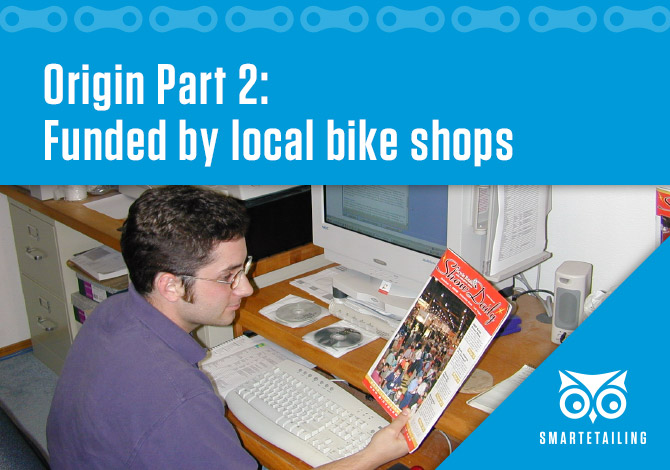
We are celebrating the 20th anniversary of the founding of SmartEtailing by reflecting in this blog series on how the bike industry’s original tech startup came to be.
In the previous post we learned how a local bike shop owner and a cycling industry marketing expert conceived of their business idea.
The vision
Mark and Barry knew that the programming behind their vision was possible. And it seemed clear that this service would help solve some of the issues Brenner experienced at his own bike store. But they had yet to validate their ideas with other bike retailers and attain startup capital. Would the bike industry sign on?
From his time at Catalyst, Graff remembered how Randy Clark, owner of Bicycle Garage Indy, told him about how he would need more help with internet marketing in coming years. So he paid him a visit and presented their early plans. “I’m in,” Clark said, handing Graff a twenty dollar bill.
“It was symbolic,” Clark recalled. He knew Graff and trusted him.
“This was a way to have a website and even more appealing, a way to be able to render products and images and descriptions that any one retailer simply could not do,” Clark said. “There wasn’t enough time in the day to do all of that.”
“This was a way to have a website and even more appealing, a way to be able to render products and images and descriptions that any one retailer simply could not do,” - Randy Clark
With Clark’s assurance that they were on the right track, Graff and Brenner continued to work on the initial plans for the company, what it would offer and all the details for what they wanted their software to do.
Still to be figured out: What would they call this new firm?
“Back then ‘etail’ was as prevalent as ‘cloud’ is today,” explained Graff. “We didn’t intend to turn retailers into ‘etailers’ because that missed the whole benefit of having a physical, local presence. That’s where ‘smart’ came to us, in that it would be smart for local merchants to approach the web differently, with a focus on nearby customers.”
Rendezvous in Vegas
With start-up funds pooled from their own savings and borrowed from family, they monitored expenses carefully. Their company had a name and its first client, yet they didn’t have enough money to risk a booth at Interbike that fall. With Interbike’s blessing, they booked a room for an evening presentation at the show’s official hotel.
A group of about a dozen retailers
Graff and Brenner didn’t know how much it would cost to have the programming outsourced, but presented their best estimate and asked dealers to commit an initial enrollment fee and a monthly subscription once the service actually started. A number of dealers wrote checks on the spot while others mailed payments soon after.
The partners raised $100,000 from that Las Vegas meeting, which expanded the startup capital for SmartEtailing.
A foundation of trust
Ultimately, after negotiating with a couple of programming contractors, the final cost was much less than anticipated and SmartEtailing was able to refund retailers a majority of their enrollment fee.
“It was all based on trust,” Graff remembered. “The dealers knew us. We told them if this doesn’t come about, we’ll refund the money. We needed to create seed capital and they believed we could deliver.”
Among the early retail adopters were Village Bike Shop in Grand Rapids, Michigan; Eddy’s Bike Shop in Ohio; Wheel & Sprocket in Wisconsin; Bike Gallery in Portland, Oregon; Bicycles
“The very first major brand to approach us was Trek in November 1999,” shared Graff. “JB had just visited Bike Gallery in Portland. My phone rang. ‘Mark, John Burke here. Got a minute? I just visited our friend Jay Graves. He told me what you're doing. It sounds like with your service, you'll have a network of local bike shop websites that represent sort of a thousand points of light with your firm at the center. Do I have that right? Very interesting. We'll talk about it more at Trek and get back to you.’”
Stayed tuned for part 3 in the series about the first websites and early adopters.



Comments